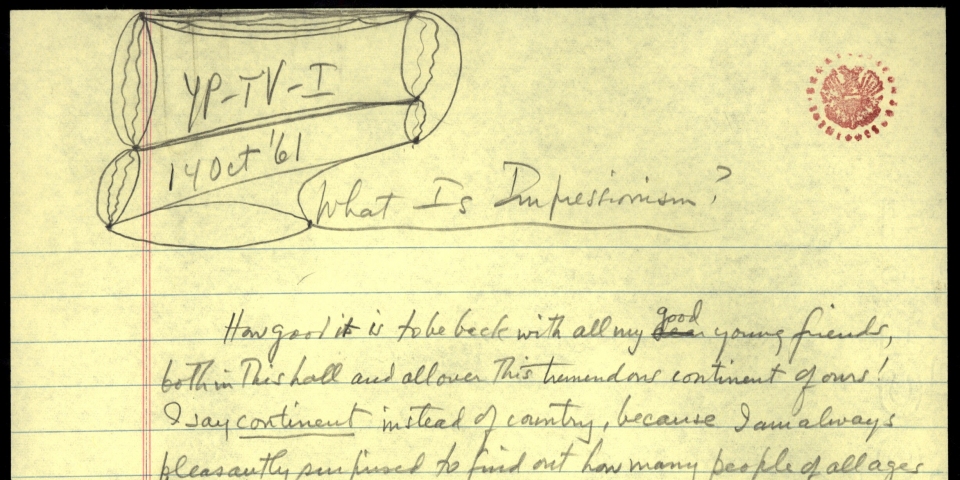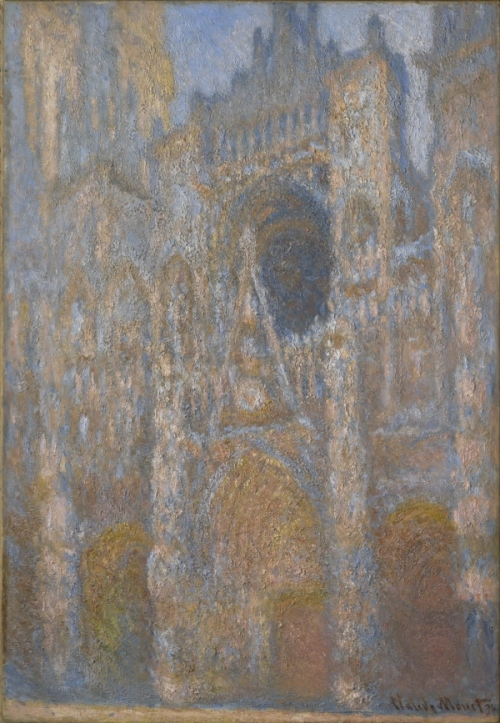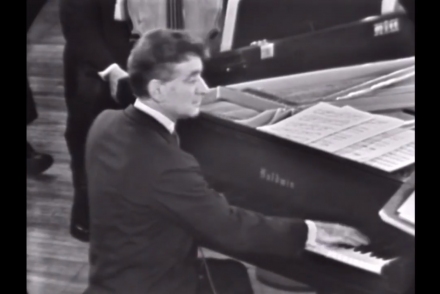Lectures/Scripts/WritingsTelevision ScriptsYoung People's ConcertsWhat Is Impressionism?

Young People's Concert
What Is Impressionism?
Written by Leonard Bernstein
Original CBS Television Network Broadcast Date: 23 November 1961
LEONARD BERNSTEIN:
It feels great to be back with all my good young friends in this hall, and all over the country; and I'd like to say a specially warm hello to our new friends up North in Canada.
Today we're going to be playing music about the sea, by the great French composer, Debussy, whom you may have heard called De'bussy or even De-bew'-sy; but however you pronounce it, Claude De-bus-sy wrote a masterpiece called La Mer, (which means "The Sea"), and it's probably the most famous music ever written about the sea.
I suppose it's pretty hard for all you New Yorkers here in Carnegie Hall to imagine that there are people who may never have seen the ocean in their lives. People in Winnipeg, for instance, which is smack in the middle of Canada.
Now if I wanted to tell someone in Winnipeg what the sea is like, I could do it pretty easily by facts and figures, or by sending him a picture postcard from Coney Island or somewhere. But that wouldn't give him the real quality of the sea, would it: what it feels like to look at it, smell it, hear it, in all its variety of stillness and storminess and playfulness. And what our friend in Winnipeg would need is an impression of the sea, not just facts or figures. And that brings us to the subject of today's concert—which is impressionism. Because this sea-piece by Debussy is what is called an impressionistic piece of music: that is, it tells you no facts, it is not a realistic description, but instead it's all color and movement and suggestion. And that's an important word: suggestion. Do you know what it means? For instance, if your father, orders you to go to sleep at 8 o'clock, simply, and clearly, that is a statement, a direct command: "go to bed". But if he just speaks softly to you about those beautiful clean white sheets, and your soft pillow, and sweet dreams, then he's suggesting that you go to sleep. "Wouldn't it be lovely to climb into bed?" And as you know, the power of suggestion is often much stronger than a straight order. That's because it's deeper, it's more subtle; those hints can creep into a deeper part of your mind than a simple command can. So that was the idea that all impressionist artists had in mind, whether they were poets, or painters, or composers—and by the way, they're almost all French. For some reason, which we won't go into today, it was a French idea, that in art you can make a deeper effect by suggestion than you can by realistic description. Actually, the whole idea of impressionism began with painters, French painters like Manet, Monet, Renoir, and all the famous other names.
Have you ever looked at an impressionistic French painting? I'm sure you have, but maybe you didn't know you were looking at one at the time; you just saw a picture that was sort of blurry and hazy, that didn't have a real look. Like this painting here by the great impressionist Monet of the front of the Cathedral at Rouen.
[SHOW]

Now you see how misty it is? In fact, it's so misty you can hardly tell what it is at first glance. Now of course, Monet's colors are missing here, which would tell you a great deal and that sort of makes it hard to see without the colors. But just for fun, now take a look at an ordinary photograph of that same cathedral at Rouen and see the difference.
[SHOW]

You see how exact all the lines are, the hard clean outlines and edges and shapes of the cathedral? Now a realistic painter would want to make his painting of the cathedral as real as possible, with the light and color and the shape exact, like this photograph. But not Monet, the impressionist painter, because he wants you to see not so much a cathedral, as light itself, light and color, as they look to him reflecting on a cathedral.
[SHOW MONET AGAIN]
Do you see the difference? Look at the Monet again. This is almost like a dream of a cathedral, an impression of it, a suggestion, as we said before of this cathedral, as seen at a certain moment of the day, when the light was a certain way. Now imagine, Monet painted over 30 different pictures of this same view in different lights—bright morning, cloudy afternoon and others; and this one—as you see, if you could only see the colors—is the cathedral in the sunset, which has turned the stone into a dazzling, blurry dance of blues and oranges and mauves. Now that's one impression of this Cathedral at Rouen.
Of course, music is completely different from painting in that it can't ever be really realistic: because notes can't ever give you the exact measurements of a cathedral or the exact shape of anybody's nose. But music can be more or less realistic in its own way: that is, it can have sharp, clear outlines like these chords:
[PLAY triadic chords]
or it can have blurry outlines like these chords:
[PLAY same chords augmented]
Do you feel that hazy, indefinite quality of these harmonies? Well, those are impressionistic harmonies.
Or music can have a straight-forward clear theme like, let's take this one of Beethoven, which you all know:
[PLAY: Beethoven - Fifth Symphony]
That's clear, direct; that's like your father saying: go to bed!
[SING: Beethoven - Fifth Symphony "Turn off that light!"]
But it can, music can also suggest with fuzzy little wisps of melody the way Debussy does like this:
[PLAY: Debussy - Preludes Bk 1: Voiles]
which is like hinting at pleasant dreams. Suggestion, you see? That's the difference.
Now later, we'll go into some of the ways that Debussy makes all this happen musically; but first I want you to listen to the opening movement of this wonderful piece about The Sea. It is called "From Dawn to Noon on the Sea", and as you listen, see if you don't get the impression—the suggestion—of the absolute stillness of the ocean just before dawn, which sounds like this:
[ORCH: Debussy - La Mer]
then you will hear, I say, hear, the first spooky rays of light:
[ORCH: Debussy - La Mer]
You see what I mean by a suggestion of rays of light? Then you will hear the first faint cries of sea birds:
[ORCH: Debussy - La Mer]
and then the waters begin to stir and rock as the first breeze come up:
[ORCH: Debussy - La Mer]
and then as the movement goes on, you will hear a bright new sound from the cellos and the horns which is like the sudden appearance of the sun over the horizon:
[ORCH: Debussy - La Mer]
You see how golden that is? And from there on the music grows in power and color and movement, until at the very end the sun has climbed to the height of noon and hangs there, blazing in space.
Now this is a great moment of musical painting that Debussy has made with his last chord of this movement, by suddenly taking away all the high notes and all the low notes from the chord, and leaving only the brass chord hanging there in the middle like a ball of fire in the middle of space. Just listen:
[ORCH: Debussy - La Mer]
Isn't that a marvelous image, you can almost see the sun shining there like a big ball. Now here is the first movement of Debussy's great tone-painting, La Mer - From Dawn to Noon on the Sea.
[ORCH: Debussy - La Mer]
Isn't that a marvelous piece of tone-painting? And that's just what it is—painting for the ear instead of the eye.
But now let's get down to the really interesting part and find out just what Debussy does to get these strange, new sounds of impressionism. I say new sounds, even though they're 50 years old or more; but they've become so imitated in American popular songs and Hollywood scores and record-album arrangements and what not that these sounds seem to us like the normal, every-day sounds. And yet, compared to the sound of Bach, Beethoven,and Brahms, they're absolutely new, brand new, and in the hands of a master like Debussy they sound as fresh today as they did 50 years ago.
Well, what are some of these way Debussy invented for getting these sounds? Let's go to the piano and find out. Remember that little bit of music I played for you before to show you how Debussy uses little wisps of melody?
[PLAY: Debussy - Preludes Bk 1: Voiles]
Now that comes from a little piano piece of his called Sails.
[PLAY: Debussy - Preludes Bk 1: Voiles]
And it paints a dreamy impression of graceful, gliding sail-boats in the afternoon sun perhaps off in the hazy distance.
[PLAY: Debussy - Preludes Bk 1: Voiles]
How does he get that hazy sound? What does he actually do? The method he uses to get this dreamy effect is one of the most important methods used in impressionist music. And it's called using whole tones. Now that's not a very hard word. Do you know what a whole tone is? It's simple: it's two half tones. Two halves make a whole, right? Right. Now if you remember that the step from any note on the piano to the note right next to it, whether it's a white note or a black note, is a step of a half-tone
[SHOW]
you can see that the whole piano is made up of only half-tones, one after another.
[SHOW]
Now out of those half-tones, we make what we call our chromatic scale; that's this one:
[PLAY: chromatic scale]
and we also make all the other scales like our ordinary major scale which is some half tones and some whole tones. And that's this one:
[PLAY: major scale]
and the last one, for instance, that last step is a half-tone. But if we start at the same place and go up only by whole tones, only whole tones, then we get Debussy's whole tone scale, which sounds like this:
[PLAY: whole-tone scale]
Listen to that:
[PLAY: whole-tone scale]
Sort of mysterious and spooky; as you can hear, it's much less definite and final-sounding than the ordinary scales.
[PLAY: major scale]
That's final.
[PLAY: whole-tone scale]
That's not final at all. And so out of this scale Debussy has made this delicious little impression of hazy sailboats in the half-light, floating, airy, and without any definite outlines.
[PLAY: Debussy - Preludes Bk 1: Voiles]
That's nothing but a whole tone scale. You see, Debussy was always searching for new colors, new sounds, and so he used every unusual kind of scale, old or new, that he could lay his hands on, including a hard one we won't go into called the pentatonic scale. But he even went back many centuries to the old Greek scales, which are called modes, and he also used the modes that were used in church music over a thousand years ago, and many other kinds of scales.
But it's not only strange scales that make Debussy's music sound different: he also used the same scales as everybody else, major and minor, but he used them in new ways; by making chords out of them that no one had ever heard before. For instance, he would take this ordinary chord of 3 notes
[PLAY: chord]
and add to it,
[PLAY: chord]
then he'd add more,
[PLAY: chord]
and more,
[PLAY: chord]
and more,
[PLAY: chord]
until it becomes a new, complicated, misty
[PLAY: chord]
impressionistic chord. Then he could take that chord later and alter notes of it slightly to give another special color to it.
[PLAY: chord]
You hear that? That's an impressionistic chord. Now here's a piano piece that uses some of those chords, and of all things this one's about goldfish, in fact it's called Goldfish. It goes like this:
[PLAY: Debussy - Images Set II - Poison d'or]
(voiceover)
Goldfish, darting about in the shimmering water. and the colors of the fish, and the light in the water are all reflected in these richly colored harmonies. Shimmery colors like those special colors we talked about in the Monet's Cathedral which unfortunately you couldn't see.
I'm not going to try to explain just what these special chords are made of, because that would be too complicated; but would like to explain to you one very special way that Debussy gets these rich blurry colors in his harmonies: and that's a trick known as bitonality. Now there's a big word you can trot out to amaze your friends sometime: bitonality. It's a big word, but it's very easy to understand; it just means two different harmonies at the same time, that is, music written in two different keys as once. Imagine! It's as though I started to play the Blue Danube Waltz in one key
[PLAY: J. Strauss - Blue Danube Waltz]
and then came in with the tune in another key. That's pretty peculiar, but that is bitonality. But when Debussy uses it, it comes out not peculiar at al, but rich, blurry and impressionistic, as it does in this marvelous piece of his:
[PLAY: Debussy - Preludes Bk 2: Puerto del vino]
Do you hear how the accompaniment is in one key, one very definite key,
[PLAY: Debussy - Preludes Bk 2: Puerto del vino]
and then the tune is in another key. But both together, the two keys make a strange, beautiful impressionistic sound, sort of dark and passionate.
[PLAY: Debussy - Preludes Bk 2: Puerto del vino]
By the way, this piece, as you've probably guessed, is a Spanish sort of music; that accompaniment is a tango of course. It's called La Puerta del Vino, and the fact that it's Spanish tells us still another thing about impressionism. Debussy, in his search for new sounds, was always going to, was attached to music of faraway places, faraway places like the Orient, or ancient Greece, or even jazz from America. Don't forget that Debussy was composing at a time when jazz—or ragtime, as it was called then—was just beginning to sweep the world. And so he borrowed some of our jazzy rhythms and ideas, and wrote a few pieces like this one, which I'm sure you've all heard or maybe even know the name of:
[PLAY: Debussy - Golliwog's Cakewalk]
Who know what that one's called? Oh good. A lot of you do. The Golliwog's Cakewalk. I won't tell you what that means. But that's the title of it anyway. In any case, that'll show you that Debussy didn't always write slow, serious music, as you may have begun to think. It's not all misty. He had a wonderful sense of humor, and I only wish there were time to go into that part of his music, too. But now it's time to get back to the second movement of La Mer, the great Sea piece of his. And this movement is called "The Play of the Waves," and is a light, sparkling impression of the sea in its most playful mood. In it you'll hear all the scales and harmonies and tricks we've been talking about — a wavy wisp of a tune in an old church mode that goes like this:
[ORCH: Debussy - La Mer]
Then you'll hear real splashes of foam coming up out of the waves. They're all made of the whole-tone scale. Sounds like this.
[PLAY: Debussy - La Mer]
There are even some Spanish rhythms in this movement, like this Bolero rhythm that suddenly comes in the middle.
[PLAY: Debussy - La Mer]
And then you'll hear bitonality, and all the rest of the things we've been talking about. But you won't hear any jazz. Well, I think by this time you're ready to hear this music of the waves and really know what's going on. You're experts, now, on impressionism; and I hope that will make you love this music as much as we do.
[ORCH: Debussy - La Mer]
Now, since you're all such experts on the subject of Debussy's impressionism, I think we can just go straight ahead and play the last movement of La Mer without any explanations at all, except to tell you that it's called "Dialogue of the Wind and the Sea," and this time the sea is pretty rough.
[ORCH: Debussy - La Mer]
Sorry, I'm having a little trouble with this microphone. Is it still working? Yes.
Before we play our next and last piece for you, I want to give you all a very sincere compliment, because I think that Debussy's La Mer is probably the longest and most complicated special piece ever played at a children's concert in its entirety; and I am very happy at how quiet and attentive you all were, and how understandingly you listened to it. Congratulations.
And now. Don't clap for yourselves. And now, we're going to end our look at impressionism with a short piece by Maurice Ravel, who is the other great French impressionist composer. It's funny how many of the great men of music seem to go in pairs, like ham and eggs: Bach and Handel, Mozart and Haydn, Mahler and Bruckner—and Debussy and Ravel. The music of these two giants together make up most of the great works of impressionism that exist. Ravel's music is sometimes very much like Debussy's, but it has a special personality of its own, too. For one thing, it's more show-off, or as musicians say: more virtuoso; Ravel's way of handling the orchestra is the most exciting and glamorous you can find in all music—and imitated by dozens of other composers, I can tell you. and his piano music is so brilliant and difficult that it's always a test of a pianist to see if he can play it at all. Which may be why I'm not going to play you any examples on the piano from Ravel. And besides, Ravel is even more attracted than Debussy was to faraway romantic places. Especially to Spain—I'm sure you've all heard Ravel's Spanish pieces, like the Bolero and the Rhapsodie Espagnole, I think this special interest of his in folk music, in exotic folk music, comes partly from his terrific interest in rhythm—rhythm for its own sake. He loves rhythm, and after all, the Bolero is practically all about rhythm, and so is that other wonderful piece of his, La Valse, which is all about the rhythm of the waltz.
We're going to play a piece of his that has all those qualities in it: it's the final dance from his famous ballet Daphnis and Chloe, which is based on legends from ancient Greece. Now that's far-away, all right; and this dance has in it the wildest rhythms you can imagine. It is also one of the great show-pieces for an orchestra; the way Ravel writes for orchestra is so brilliant, and famous all by itself, just as orchestration, never minding the music. But you'll also hear in it most of the things we found in Debussy's music: whole-tone scales and old Greek modes (which is natural in an old Greek ballet) and bitonality, and blurry chords and all the rest of the things you've learned today. So here is the final dance from Ravel's Daphnis and Chloe.
[ORCH: Ravel - Daphnis and Chloe]
END
© 1961, Amberson Holdings LLC.
All rights reserved.
